Continuous Performance Management: The Complete 2025 Guide
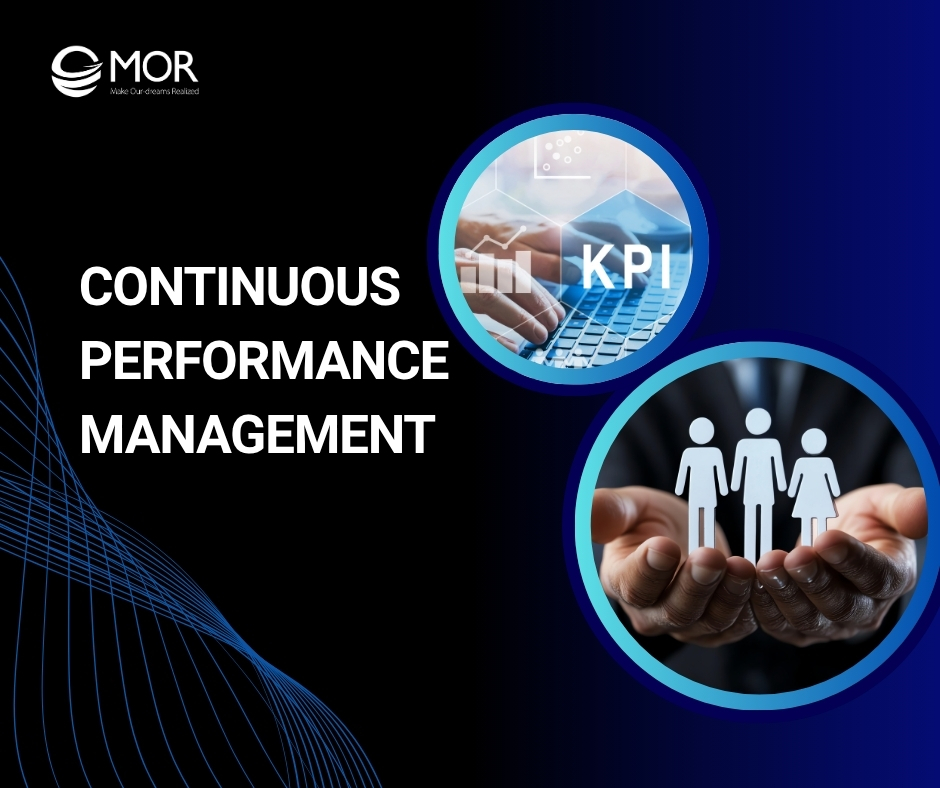
Building a strong team starts with more than just annual reviews, it requires real-time conversations and growth-driven feedback. Continuous performance management helps businesses replace outdated review cycles with ongoing development and measurable progress. This MOR Software’s guide will show how to apply this approach effectively using strategy, technology, and culture to keep teams engaged and performing well.
What Is Continuous Performance Management?
Continuous performance management is a modern, people-first method for improving how employees grow and perform. McKinsey’s research finds that companies that focus on their people’s performance are 4.2 times more likely to outperform peers, with about 30% higher revenue growth and attrition five points lower. This is why many organizations now anchor performance in everyday habits rather than once-a-year rituals.
It helps companies build trust and create an environment where people take ownership of their development instead of waiting for yearly reviews.
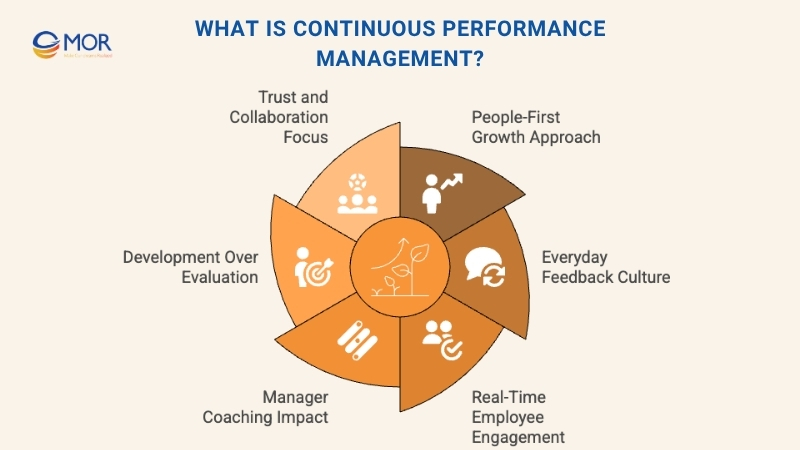
In workplaces that practice continuous feedback performance management, feedback becomes a normal part of daily interactions. Employees exchange real-time input that can be positive, instructive, or corrective, helping everyone learn faster and stay aligned with team goals. Gallup found that about 80% of employees who got helpful feedback within the past week felt fully engaged in their work. This shows how regular and specific feedback can make people feel more connected and motivated.
When teams commit to this type of management, they:
- Encourage a growth mindset by keeping feedback quick, informal, and consistent.
- Build stronger relationships through open communication and effective coaching between employees, managers, and mentors. Harvard Business Review found that around 70% of the difference in employee engagement comes from the manager’s influence. This means leaders who build strong coaching habits can make a major difference in how motivated their teams feel.
At its core, continuous performance management focuses on development rather than judgment. It shifts attention from one-time reviews like annual performance reviews to ongoing conversations that inspire progress. Employees learn how to manage up, work closely with supervisors, and feel comfortable sharing feedback across all levels.
This approach supports both individuals and organizations in reaching their potential. It transforms performance management from a routine human resource development task into a real time performance management system that continuously drives learning, collaboration, and success.
Core Components Of A Continuous Performance Management System
A strong continuous performance management system relies on consistent communication, collaboration, and visibility. These elements work together to keep employees engaged, aligned, and accountable. Below are the core features that make this process successful.
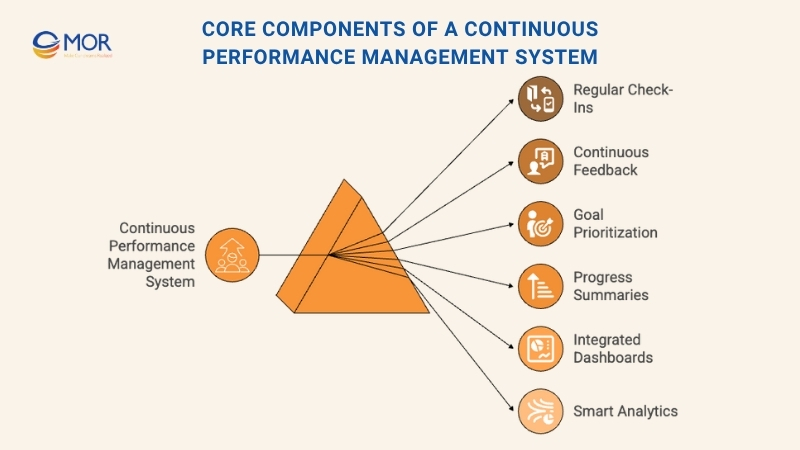
- Regular Check-ins: Frequent one-on-one discussions create trust and keep everyone aligned. Employees and managers connect often to review progress, address challenges, and share recognition in real time.
- Continuous Feedback: With a performance management continuous feedback model, employees can request advice or input from peers, mentors, and supervisors whenever they need it. This encourages a culture of open learning and shared growth.
- Goal Prioritization: Setting short-term objectives that connect directly to company goals helps employees stay focused and motivated. These priorities can be adjusted as needs evolve.
- Progress Summaries: Managers use simple summaries to track development, guide feedback sessions, and make informed decisions about performance.
- Integrated Dashboards: A centralized continuous performance management software dashboard brings together real-time feedback, check-in history, and goal tracking in one place. It helps teams visualize performance and identify patterns early.
- Smart Analytics: Advanced analytics reveal how individual and team performance changes over time. With data-driven insights, companies can refine their continuous performance management process and strengthen overall engagement.
>>> Explore the key current HR tech trends 2025 shaping smarter, more competitive organizations.
Key Benefits Of Continuous Performance Management
A well-designed continuous performance management approach drives stronger engagement, trust, and long-term growth. It replaces outdated annual reviews with ongoing feedback that keeps people motivated and aligned with company goals.
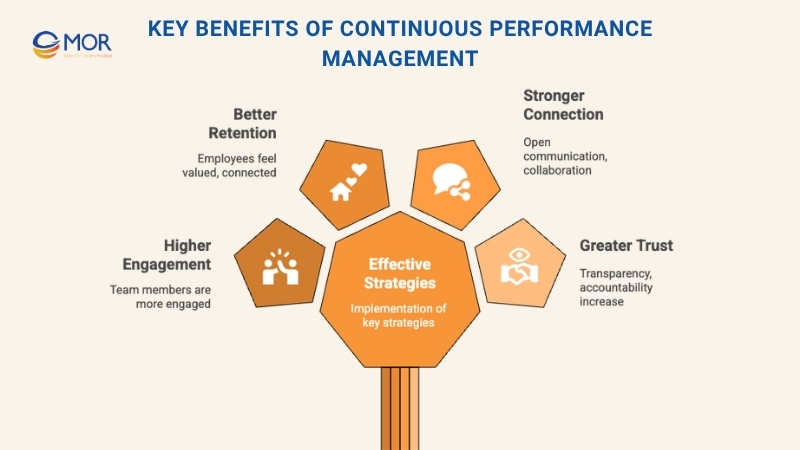
- Higher Engagement Levels: When managers talk regularly with employees about their goals and progress, engagement rises dramatically. Studies show that employees who receive ongoing discussions and daily input from their managers are almost three times more engaged. This highlights the power of performance management continuous feedback in building motivation and accountability.
- Better Retention Rates: Teams that maintain consistent communication and regular check-ins see turnover risks drop by nearly 15%. This proves that frequent feedback and recognition are not only good for morale but also vital for retaining top performers.
- Stronger Connection Across Teams: Modern organizations rely on collaboration across departments. A connected continuous feedback performance management process supports this by linking people through shared goals, coaching, and transparent communication rather than isolated one-on-one reviews.
- Greater Trust and Transparency: Trust grows when managers provide honest, ongoing feedback. Research shows that employees who trust their leaders are almost twice as likely to stay engaged and satisfied with their work.
- Data-Driven Insights: With advanced continuous performance management software, companies gain real-time analytics about goals, collaboration, and performance trends. This continuous stream of information helps HR and leaders make smarter decisions, identify hidden talent, and strengthen the overall employee performance management strategy.
Traditional Vs. Continuous Performance Management
The biggest difference between traditional and continuous performance management lies in timing and focus. Traditional reviews happen once or twice a year and mainly look backward, while continuous methods emphasize ongoing conversations, real-time insights, and employee growth.
Category | Traditional | Continuous |
| Review Frequency | Held once or twice a year, often formal and delayed. | Ongoing check-ins and real-time conversations. |
| Focus | Evaluates past actions and missed targets. | Prioritizes development, learning, and future objectives. |
| Goal Setting | Fixed yearly goals that rarely adapt. | Flexible, evolving goals adjusted through the continuous performance management process. |
| Communication Style | One-sided discussions led by managers. | Open, two-way performance management continuous feedback that builds collaboration. |
| Review Structure | Highly structured and formal. | Informal, frequent, and embedded in daily work. |
| Evaluation Method | Traditional ratings and annual accenture performance review formats. | Real-time metrics, goal tracking, and ongoing coaching. |
| Integration Into Work | Happens after performance cycles. | Integrated continuously into everyday workflows. |
| Issue Management | Reactive and often delayed. | Preventive, identifying and solving issues early. |
| Employee Engagement | Lower, since feedback arrives too late. | Higher, as employees feel supported and heard through constant communication. |
In short, continuous methods turn performance reviews into an everyday habit instead of a yearly event. This approach helps teams stay aligned, engaged, and ready to improve throughout the year.
How To Implement Continuous Performance Management?
Implementing continuous performance management means shifting from occasional reviews to ongoing conversations that include real-time feedback, short-term goals, and regular development talks. This approach removes the stress of annual performance reviews and builds stronger connections between managers and employees.
It also increases buy-in from teams and helps leaders design more effective improvement strategies that actually drive growth. Transitioning successfully to this system requires clear planning and collaboration at every level.
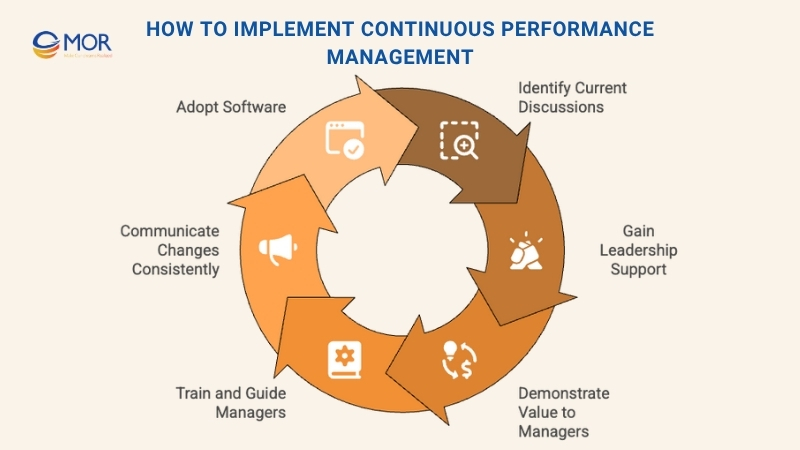
1. Identify Current Performance Discussions
If managers already struggle to complete yearly reviews, it can seem unrealistic to expect frequent check-ins. But introducing continuous performance management doesn’t mean starting from zero. Many organizations find that informal conversations are already happening naturally.
Start by talking to managers to learn who is already having these discussions. Ask how they conduct one-on-ones, how often they meet with team members, and what topics they typically cover. You’ll often discover that small pieces of a hrm models already exist.
Involving managers early is crucial. Their insights will shape how your organization moves from formal reviews to continuous dialogue. Encourage them to share what works, what doesn’t, and how the process could be improved to support a true continuous performance management theory in action.
2. Gain Leadership Support For Continuous Performance Management
Getting executive buy-in is the foundation of any continuous performance management rollout. When top leaders understand and support the change, the rest of the organization will naturally follow. Employees are more willing to participate when they see their managers and executives leading by example.
Some resistance is normal, especially when replacing long-standing annual performance reviews. To earn leadership support, present evidence showing how this shift improves productivity, engagement, and business results. Highlight case studies and research that demonstrate the long-term gains of a continuous performance management system.
Be ready to answer practical questions about how high and low performers will be identified, how promotions and pay adjustments will work, and how fairness will be maintained. Clarity on these topics helps build trust and confidence among decision-makers.
Finally, show how tracking key internal metrics, like engagement, communication quality, and performance trends, supports ongoing improvement. Demonstrating how real time performance management ties into measurable outcomes will make leaders more confident about the transition.
3. Demonstrate The Value To Managers
Managers are more likely to embrace continuous performance management when they clearly understand how it benefits them and their teams. HR should communicate the purpose behind the transition, explaining why this approach replaces outdated reviews and how it leads to stronger, more consistent results.
Emphasize that regular check-ins build engagement, motivation, and accountability. They make it easier to address challenges early and celebrate wins more often. Managers will soon realize that ongoing conversations save time compared to lengthy annual performance reviews, which often feel rushed and disconnected from day-to-day work.
Show them that continuous feedback performance management creates better communication and helps develop stronger teams. When managers see the direct link between frequent discussions and improved results, they’ll become active supporters of the process.
4. Train And Guide Managers Effectively
Once your continuous performance management system is in place, proper training becomes essential. Managers need to know how to hold productive conversations, give constructive feedback, and set short-term goals that align with business priorities.
Use the time once spent on annual performance reviews to coach managers on facilitating meaningful discussions and practicing active listening. Not every leader naturally knows how to deliver effective feedback, so structured workshops and role-based training can make a major difference.
Bottom Line
A strong continuous performance management process builds a lasting feedback loop that fuels growth, accountability, and engagement. When managers are confident in their communication skills, the entire organization benefits.
5. Communicate Changes Consistently
Clear, ongoing communication is key to a smooth shift toward continuous performance management. Both employees and managers may need time, guidance, and multiple conversations before they fully understand and adopt the new approach.
Avoid sending just one announcement and expecting everyone to adjust. Instead, plan a steady communication effort that keeps the message visible and consistent. Use different formats, email updates, short videos, in-person meetings, webinars, and quick reference guides, to explain how continuous performance management software will work and why it matters.
When everyone feels informed and included, the transition becomes easier, and the new system gains stronger acceptance across the organization.
6. Adopt Continuous Performance Management Software
The right technology makes continuous performance management easier to implement and sustain. Modern analytics tools streamline scheduling, enable real-time feedback, and help managers and employees track SMART goals that evolve with business needs.
Using continuous performance management software, HR teams can record one-on-one meetings, store feedback notes, and monitor development trends across departments. These platforms also highlight recurring issues early, allowing managers to respond before they grow into bigger challenges.
Accurate performance data gathered from the system helps evaluate how well the new process is working. Over time, this digital foundation supports a stronger, data-driven approach to employee performance management that benefits the entire organization.
What Is The Role Of HR In Continuous Performance Management?
HR teams are central to making continuous performance management work. They ensure every part of the process aligns with company goals, supports employee growth, and builds a culture of open communication. The HR function connects strategy, people, and technology to keep the system running effectively.
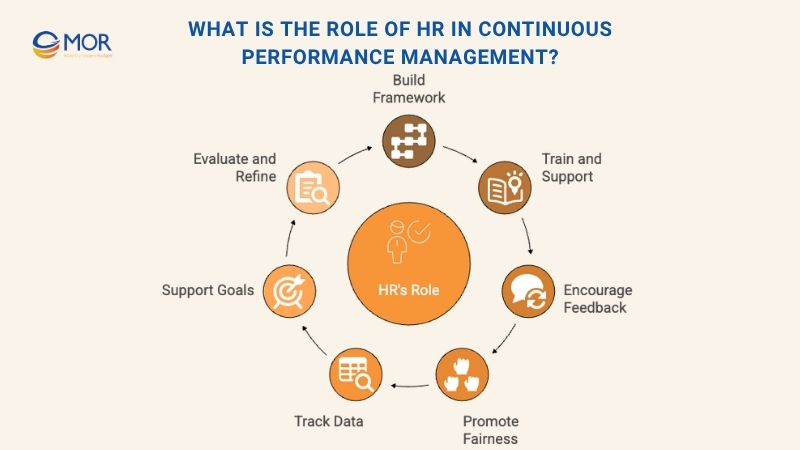
1. Building And Implementing The Framework
HR designs the structure for continuous performance management, defining how feedback, coaching, and goal-setting take place. They make sure the process fits the company’s culture and objectives while staying consistent across departments. HR also selects and manages the right tools to support real time performance management, allowing continuous tracking and transparent communication between managers and employees.
2. Training And Ongoing Support
HR leads the training process, helping managers and employees understand how to use the system effectively. This includes coaching managers on how to provide meaningful, constructive feedback and conduct effective one-on-one meetings. Beyond training, HR serves as a constant support system, answering questions, addressing concerns, and reinforcing the benefits of the continuous feedback performance management approach.
3. Encouraging Consistent Feedback
HR plays a key role in promoting a workplace where feedback is continuous, open, and productive. They help normalize real-time conversations so that recognition and coaching become part of daily operations, not just occasional events.
To make this possible, HR defines clear channels for sharing feedback, regular one-on-one meetings, quick performance check-ins, and digital communication tools that keep exchanges transparent and accessible. This approach strengthens trust and builds engagement across teams.
4. Promoting Fairness And Consistency
HR ensures that continuous performance management remains equitable by creating standardized evaluation methods and clear performance guidelines. They work with managers to make sure every assessment follows the same principles, reducing bias and subjectivity.
Through proper training and awareness programs, HR helps leaders evaluate performance based on measurable outcomes and shared goals. This consistency builds confidence in the process and reinforces the credibility of the continuous performance management theory throughout the organization.
5. Tracking And Analyzing Performance Data
HR teams use data from continuous performance management software to monitor progress, identify trends, and support decision-making. By reviewing real-time feedback and check-in records, they can spot skill gaps, productivity patterns, and areas where additional support is needed.
HR also assists managers in interpreting this data, turning numbers into insights about employee growth and team performance. This data-driven approach allows the organization to fine-tune its continuous performance management process and strengthen overall workforce development.
6. Supporting Goal Setting And Employee Development
HR ensures that every employee’s goals align with the company’s broader strategy. They work with managers to set, review, and adjust objectives that balance business priorities with personal growth.
Through collaborating on individual development plans, HR helps employees close skill gaps, plan career paths, and stay motivated to improve. This alignment between organizational vision and personal goals keeps employee performance management meaningful, measurable, and forward-looking.
7. Evaluating And Refining The Process
HR’s role doesn’t end once continuous performance management is in place. They actively gather feedback from employees and managers to understand what works and what needs adjustment. Regular evaluation ensures the system evolves with the organization’s goals and workforce dynamics.
When analyzing engagement data and feedback patterns, HR identifies opportunities to simplify processes, strengthen communication, and improve coaching effectiveness. This ongoing review helps maintain the momentum of the continuous feedback performance management cycle.
Forward-thinking companies often adopt a “feedback about feedback” approach. For example, organizations like Aquatic use automated tools to collect performance insights and refine their systems continually, saving significant time and improving data accuracy across their best performance management system.
>>> Highlight the best HR chatbots in 2025 and how they are reshaping HR operations!
Challenges In Continuous Performance Management Implementation
Transitioning to continuous performance management brings many benefits, but it also comes with real challenges that organizations must plan for. Adapting to new habits, systems, and expectations takes time and effort from everyone involved.
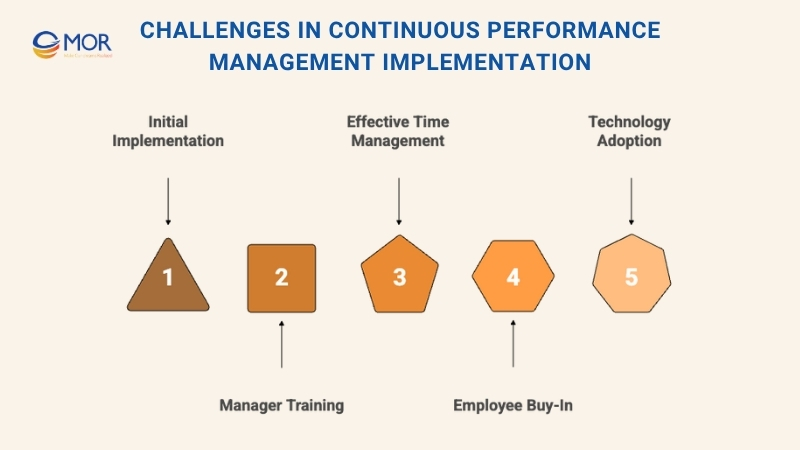
- Manager Training: Not all managers naturally know how to give constructive feedback or lead effective check-ins. Ongoing coaching and support are crucial to help them master these skills.
- Consistency Across Teams: Larger organizations often struggle to apply a unified continuous performance management process. Without standard practices, the quality of feedback and engagement can vary widely.
- Time Management: Regular discussions require time and attention. Managers must learn to integrate short check-ins naturally into their schedules without overwhelming their workload.
- Employee Buy-In: Some employees prefer traditional reviews and may hesitate to adopt continuous feedback. Explaining the benefits of continuous performance management and showing its impact on growth can help overcome resistance.
- Technology Adoption: Getting everyone comfortable with continuous performance management software can be challenging, especially for teams less familiar with digital tools. Providing clear instructions and hands-on training can make the transition smoother.
Despite these hurdles, consistent communication, leadership support, and a focus on learning can turn these challenges into opportunities for lasting cultural change.
How Technology Enhances Continuous Performance Management
At MOR Software, we develop digital solutions that transform how organizations manage performance, communication, and employee development. Our HR outsourcing Vietnam platforms replace outdated annual reviews with a continuous performance management model that is transparent, measurable, and easy to scale.
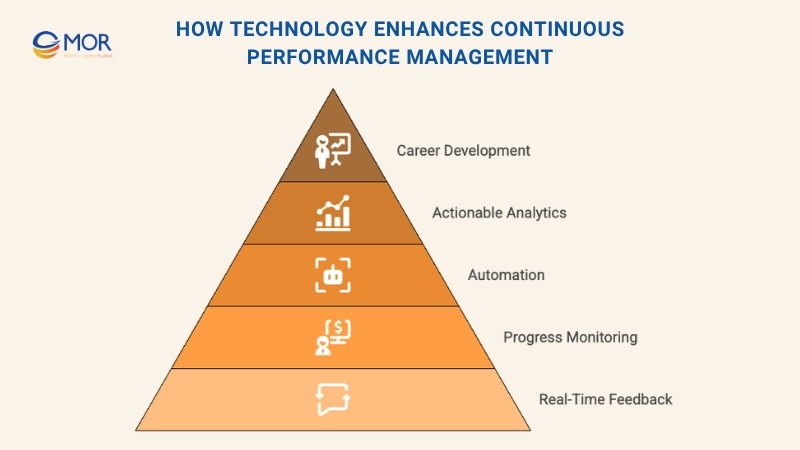
With advanced tools built by MOR, businesses can:
- Strengthen communication using real-time feedback channels that connect employees and managers instantly.
- Monitor progress with interactive dashboards and powerful analytics that visualize team performance.
- Automate routine tasks like scheduling, reminders, and documentation to save time and maintain consistency.
- Generate actionable insights from engagement data, helping leaders make smarter decisions about talent and growth.
- Support career advancement through guided learning paths and progress tracking for every employee.
Integrating workflow automation, analytics, and intuitive design, MOR Software empowers companies to keep performance discussions active all year long. This technology-driven approach helps teams stay aligned, motivated, and ready to grow together.
Ready to strengthen your workforce with smarter tools? Contact MOR Software to discover how our custom continuous performance management software can help your organization thrive.
Conclusion
Continuous performance management is reshaping how companies inspire growth, strengthen communication, and track real progress. By focusing on real-time feedback and data-driven insights, businesses can create a culture where improvement never stops. At MOR Software, we build solutions that make this transformation simple and scalable. Our technology empowers teams to stay connected and motivated all year round. Ready to elevate your workforce? Contact us today to start your journey.
MOR SOFTWARE
Frequently Asked Questions (FAQs)
What is continuous performance management?
Continuous performance management is an ongoing process where managers and employees engage in regular check-ins, feedback sessions, and goal discussions throughout the year instead of relying only on annual reviews.
What is the main goal of continuous performance management?
The main goal is to align individual objectives with company goals while improving communication, accountability, and professional growth through ongoing conversations.
What are the key elements of the continuous performance management process?
A complete process usually includes goal setting, frequent check-ins, real-time feedback, performance tracking, coaching, and regular reviews to discuss growth and achievements.
What is the continuous performance management process?
It typically follows four steps:
- Plan: Define short-term goals that align with business priorities.
- Act: Execute tasks and track progress.
- Monitor: Provide consistent feedback and support.
Review: Assess outcomes, celebrate success, and plan for the next cycle.
What is the continuous performance management theory?
The theory behind it centers on continuous improvement and motivation. It draws from behavioral science and agile principles, promoting frequent dialogue, coaching, and data-based decision-making.
How does continuous performance management differ from traditional reviews?
Traditional reviews happen once or twice a year, focusing on past results. Continuous performance management focuses on ongoing development, with real-time feedback and dynamic goal adjustments.
How do you implement continuous performance management?
Start by training managers to hold productive check-ins, adopting a feedback tool or platform, defining measurable goals, and encouraging open communication across teams.
What are the benefits of continuous performance management?
It boosts employee engagement, improves goal clarity, enhances trust between employees and managers, reduces turnover, and provides better insight into team performance.
How often should managers hold performance check-ins?
Check-ins can happen weekly, bi-weekly, or monthly depending on team size and project pace. The key is to make them consistent, short, and focused on progress and development.
What role does HR play in continuous performance management?
HR designs the framework, ensures fairness in evaluations, provides tools and training, and tracks company-wide performance data to guide strategic decisions.
What are the challenges of implementing continuous performance management?
Common challenges include lack of manager training, time constraints, inconsistent feedback, and resistance to changing long-standing review systems.
How can technology support continuous performance management?
Modern tools can automate scheduling, track goals, analyze engagement data, and simplify feedback collection, making the process more transparent and scalable across teams.
What skills do managers need for continuous performance management?
They should be good listeners, skilled in giving constructive feedback, capable of coaching employees, and able to align team goals with broader business objectives.
How does continuous feedback impact employee performance?
Frequent, constructive feedback helps employees stay focused, improve faster, and feel more valued, which directly increases motivation and productivity.
What metrics are used to measure the success of continuous performance management?
Key metrics include employee engagement scores, goal completion rates, turnover rates, feedback frequency, and improvement in individual or team performance over time.
Rate this article
0
over 5.0 based on 0 reviews
Your rating on this news:
Name
*Email
*Write your comment
*Send your comment
1